As a jewelry professional you know just how special fancy color diamonds are. Here's everything you need to know to brush up on your knowledge.
There are few gemstones that rival the rarity of fancy color diamonds. I am going to break it all down for you and hopefully inspire you to fall in love with these exquisite treasures.
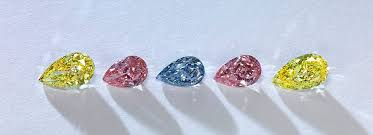
Fancy Colored Diamonds – An Overview
Diamond is the hardest substance on earth and can be polished and faceted to bend and reflect light like no other gem material. The results are an explosion of spectral colors, white light, and sparkle that leaves the viewer in awe.
When you combine these characteristics with color, the results are spectacular. Fancies come in every color in the rainbow. Whether soft pastel hues or rarely pure, strong, intense saturated colors, you know that you are looking at something that is rare to behold!
Fancy color diamonds are one of Mother Nature's greatest achievements. They are not exactly mainstream as only about one in 10,000 diamond crystals will qualify as a fancy color; these diamonds are among the most sought-after in the world.
Although royalty and rulers of Asian and European empires sought out and coveted colored diamonds for their gemstone collections, prior to the 1970s there was little commercial interest in these stones. But today we see the rich and famous buy buy engagement rings featuring the rarest colors.
A diamond dealer once told me that when he found these anomalies in the parcels of small colorless diamonds delivered to him; he would pluck them out and throw them in his desk drawer and forget about them. Years later he sold what was less than a handful of tiny colored diamonds for $64,000
Today auction houses, dealers, and prestige jewelers are in fierce competition to acquire the best and rarest stones for their top-tier clients.
How Do Gemological Laboratories Classify Fancy Color Diamonds?
Most people are familiar with the 4Cs of diamond grading: Color, Cut, Clarity, and Carat Weight. These are the factors used to assess diamond rarity for colorless and near-colorless diamonds.
When it comes to fancy color diamonds the only two of the 4Cs that really matter are color and carat weight, but the quality of the color is paramount. Rather than the D-Z scale used to grade nuances in color in “white” diamonds, color descriptions (see below) are assigned by highly trained diamond graders or sophisticated machines that measure and analyze color.
Colors: Red, orange, yellow, green, olive, blue, purple, white, brown, gray, black, and pink, are the 12 main hues.
Variations in saturation (depth of color) and the effects of modifying colors (second or third colors that are also visible e.g., purplish-pink, or brownish purplish-pink) result in an infinite amount of possibilities.
Graders evaluate three components of color:
Hue
- the basic body color that dominates
Tone
- refers to lightness or darkness of the hue
Saturation
- the purity of the hue, amount, and quality of a secondary color in contrast to the dominant color.
The classification of color as defined by the Gemological Institute of America (G.I.A.):
- Faint
- Very Light
- Light
- Fancy Light
- Fancy
- Fancy Intense
- Fancy Vivid
- Fancy Dark
- Fancy Deep
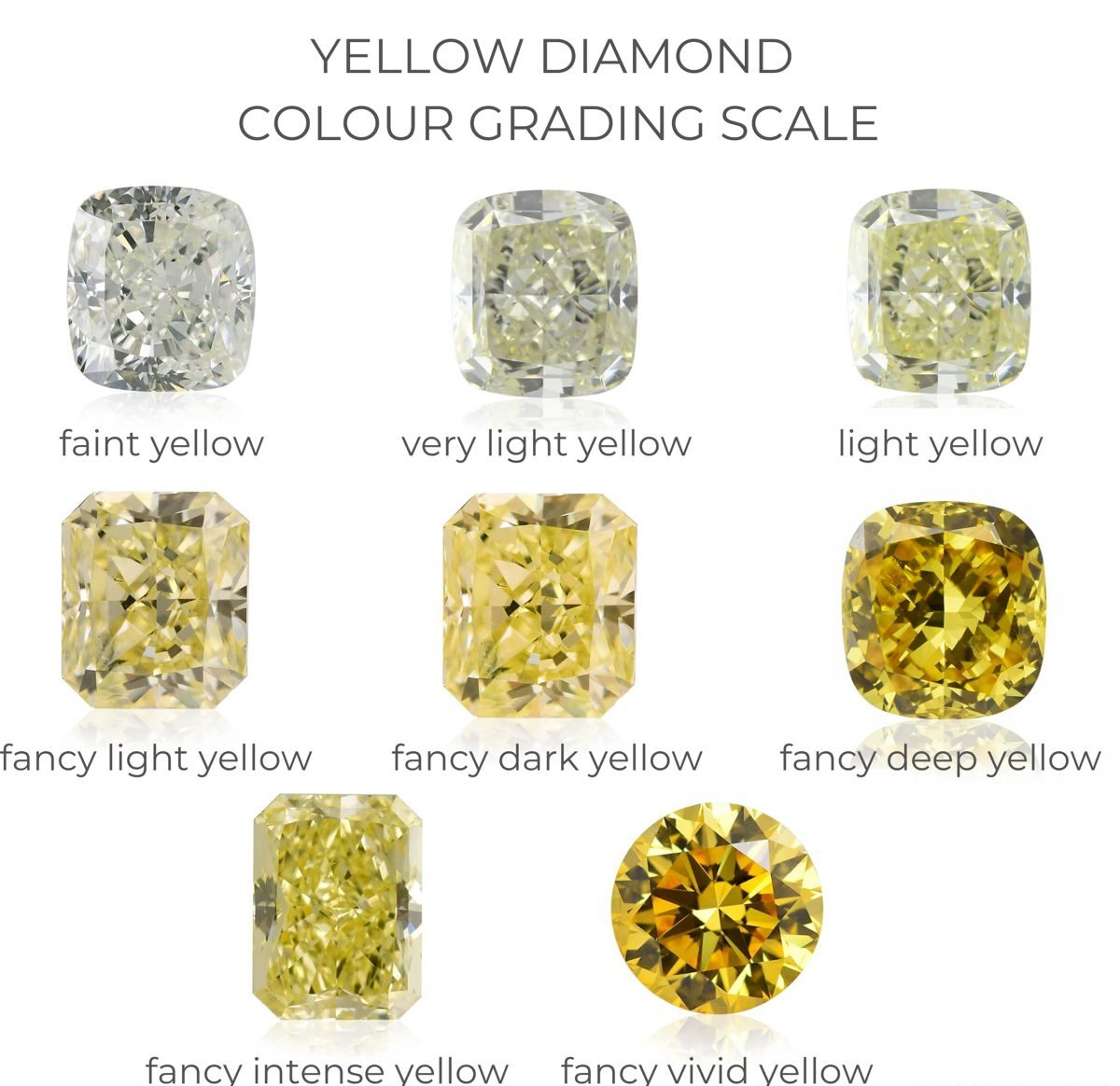
Color: What causes the colors?
- Trace elements within the atomic structure: nitrogen, boron, or hydrogen atoms that replace carbon atoms.
- Defects in the crystal lattice (atomic arrangement, misalignment of the atoms) of a diamond.
- Radiation deep within the earth is responsible for the color of fancy green diamonds, radiation causes misalignment of crystals’ structure.
But before we look at the individual colors let’s address the remaining Cs and the general guidelines that apply to fancy-color diamonds.
Cut:
Master cutters fashion colored diamonds into fancy shapes (any shape other than round) to maximize color-most often square or rectangular modified brilliants. They are often cut deeper which helps to strengthen and bring out the color.
It can take months or even years for a cutter to analyze a rough crystal before deciding exactly how it will be cut to maximize its beauty and liveliness.
Clarity:
Fancy color diamonds tend to have more inclusions than the colorless and near-colorless range. Fancy color diamonds may have significant internal characteristics and are never-the-less valued at hundreds of thousands of dollars per carat. For collectors, it is much better to own a fancy color with strong color and has inclusions (flaws) than a pale, low saturated color without inclusions.
Carat Weight:
Dealers price most fancy color diamonds individually as each one is unique. Diamonds with strong saturated colors that are extremely rare will command jaw-dropping prices. Even small diamonds, less than, 0.50 carats, in rare colors can be tens of thousands of dollars per stone. Large stones will go for whatever someone is willing to pay. It’s all about supply and demand.
Individual Colors
Next, we will look at each major color categorie: Images are enlarged to emphasize colors.
Fancy Yellow Diamonds
- The second most common of the fancy colors (after brown) is yellow and can be found in all sizes.
- Nitrogen atoms replace carbon atoms in the molecular structure which produces the yellow hue.
- Terms like “Cape” or “Canary” were descriptors for almost any diamond that exhibited enough yellow to qualify as a fancy.
- In the 1970s the G.I.A. introduced the grading scale above that replaced subjective descriptors. This was beneficial it is in a standard language to classify fancy colors that could be used by all who traded these rarities.
Sources:
Sierra Leone, South Africa, Brazil, Australia, Canada, Russia

Fancy Pink Diamonds
- The pink color in diamonds can be caused by either nitrogen or defects within the crystal structure of the diamond. These defects are visible to the naked eye and are described as pink graining.
- Internally, visible pink needle-like inclusions may be evident and will show a concentration of pink, more so than the surrounding area, which may be colorless.
- When this is the case, it presents major difficulties for the cutter, as the crystal must be oriented and cut to exhibit the most saturated color in the face-up position.
- In April 2017, the Pink Star diamond, 59.60 carats, Fancy Vivid Pink mined in South Africa in 1999 became the most expensive gem ever auctioned at $71.2 million.
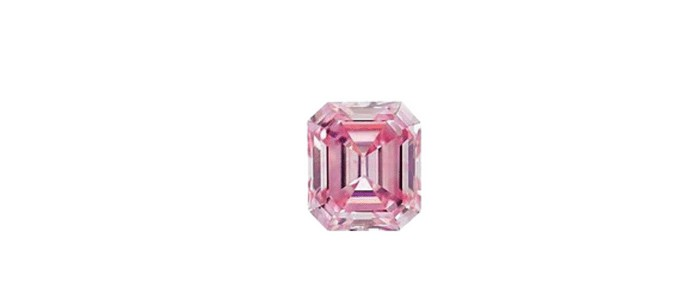
Sources:
Fancy pink diamonds come from: Australia, Brazil, India, Russia, Canada, South Africa, Sierra Leone, Angola, Central African Republic.
Fancy Blue Diamonds
- Fancy blue diamonds are the result of boron or hydrogen trapped within the crystal as it forms.
- The tone of all blue diamonds is extremely important. Most blues possess pale hues and light tones, but any amount of perceived blue will make a diamond valuable due to its rarity.
- Pure blue diamonds do exist, and are premium priced. The majority of fancy blues show gray secondary colors. e.g., fancy grayish-blue and greenish-blue. The latter are considered rarer and more valuable.
Sources:
South Africa, India, the Central African Republic, South Africa is responsible for 90% of blue diamonds in the world.

Fancy Green
- The cause of color in green diamonds is the result of the crystal’s exposure to natural radiation that occurs 100 miles below the surface of the earth.
- Radiation exposure may occur just on the surface, slightly below the surface or deep within the diamond, which results in various shades of green.
- These diamonds are not radioactive, therefore, there is no danger to anyone exposed to them.
Sources:
Guyana, Brazil, Venezuela, Borneo, India, Africa, South America.

Fancy Orange
- Orange is caused by nitrogen or distortion of the crystal lattice.
- Pure orange is one of the rarest fancy colors.
- Although yellow and orange diamonds are colored by nitrogen, it is the difference in the arrangement of the nitrogen atoms in orange crystals that result in the color.
- Pure orange diamonds are sometimes called Pumpkin diamonds.
Sources:
South Africa, Central African Republic, South America.
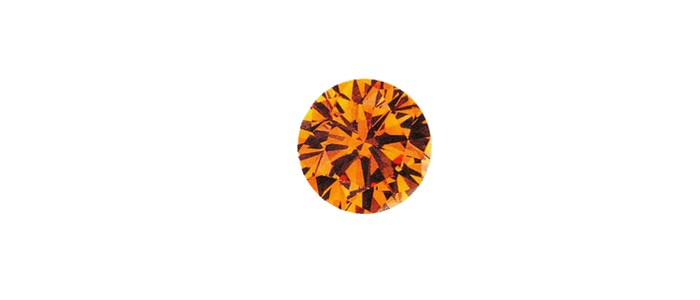
Fancy Red
- Red diamonds are the rarest of all categories of colored diamonds.
- Only a handful of pure red diamonds have ever been mined.
- The color is the result of internal graining, a distortion or misalignment of the atomic structure.
- Most red diamonds are quite small, with visible internal characteristics, and are so dark they are undesirable.
- Pure red diamonds without modifiers do exist, and they are premium priced.
- Most red diamonds have purple and pink secondary or modifying hues.

The largest red diamond ever cut is the Moussaieff Red weighing 5.11 Carats.
Sources:
Argyle Mine in Western Australia (now closed) Brazil, India, Africa
Fancy Purple
- The color is caused by internal graining, a distortion or lack of symmetry in the atomic structure.
- Secondary hues, are often present and influence the intensity and saturation of the purple hue. The most common are pink and brown.
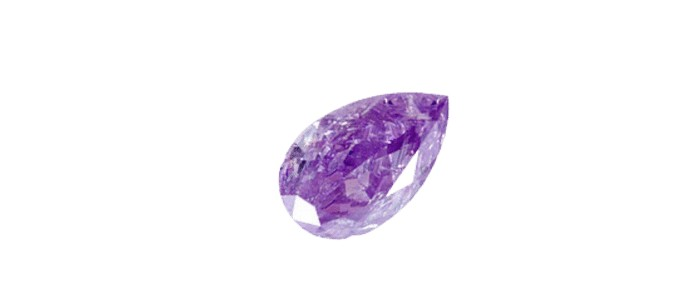
Countries of Origin:
Argyle Mine (now closed) Russia Brazil and Canada
Fancy Brown
- Brown is the most common hue when it comes to colored diamonds.
- The cause of color is the displacement of carbon atoms and graining, seen as parallel lines where color concentrates.
- Another popular name for brown diamonds is "cognac" especially if flashes of orange are observed.
- Australia was the first to promote light brown diamonds by marketing them as "Champagne" diamonds.
Sources:
Australia, Borneo, and most mines of origin: Most mines produce brownish diamonds; however, Australia is an important source.
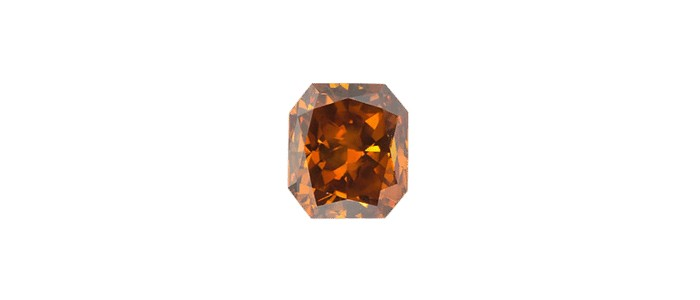
Black Diamonds
- All black diamonds feature internal crystals such as pyrite, hematite, and graphite; as well as breaks within the stones that give them their black color. If these mineral particles are distributed evenly, the stone will be opaque and if not, colorless areas will be visible.
- Only recently have they attained commercial value status,
- Many stones are heated to melt internal crystals to even out the color.
- Used primarily as accent stones or with colorless diamonds for contrast in paved designs.
- Relatively inexpensive compared to diamonds that feature spectral colors.
- They have a certain “cool” factor, brought about when Mr. Big presented Carrie a five-carat black diamond engagement ring at the end of the 2010 film Sex and the City
Sources:
Central Africa along river banks, Brazil
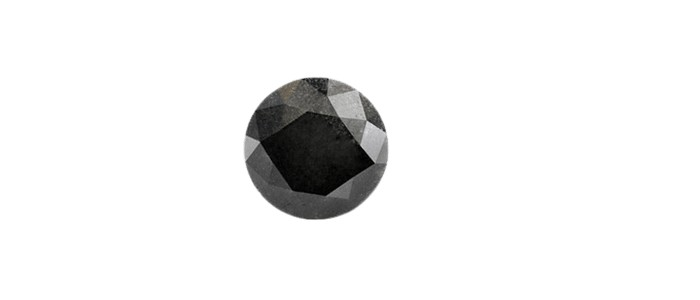
Gemological Reports
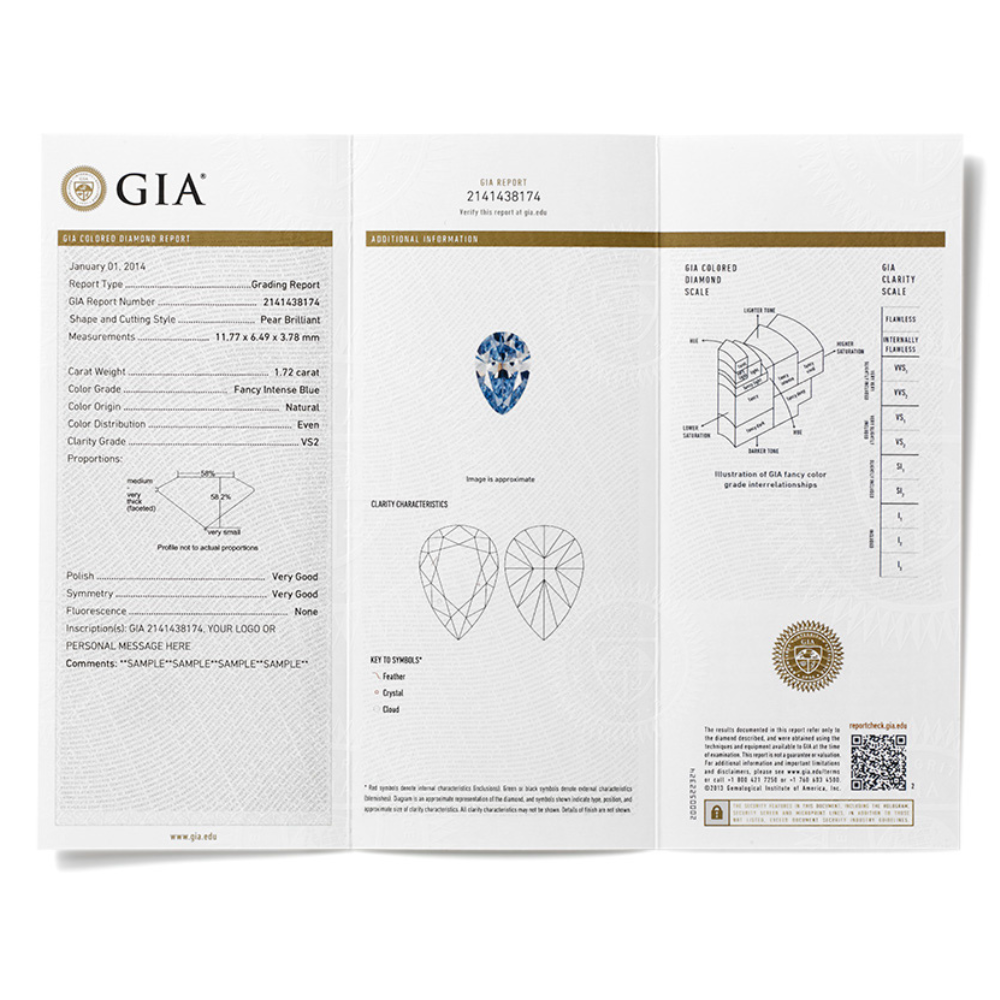
When considering the purchase of a fancy color diamond, it is critical that the diamond is accompanied by a grading report from an established gemological laboratory.
The report must provide evidence that the diamond and color are natural in origin (not man-made or color enhanced in a laboratory.) It will also assign a color grade on the G.I.A. fancy color grading scale, as well as details on the cut, carat weight, and clarity.
These details will give customers confidence in their purchases and is a document essential for resale and insurance purposes.
For more information on fancy color grading reports from the GIA-GTL, click here
In Conclusion
If you were looking for a brief review of the basics on fancy color diamonds (or are learning about them for the first time) I hope your questions have been answered.
Fancy Color Diamonds are rare, valuable and like works of art, one of a kind; And most of all, role models of beauty and perfect as engagement rings!
Thank you for reading my article and I look forward to your questions and comments below!
Francesca, G.G., F.G.A.


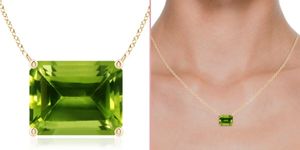
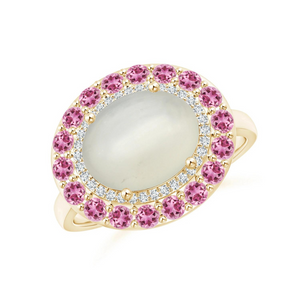
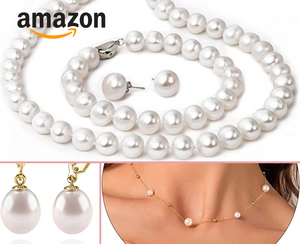
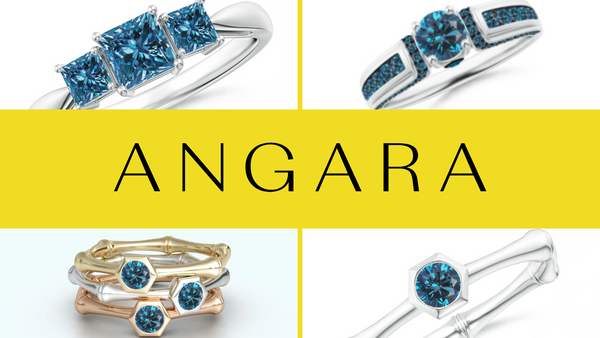
Member discussion